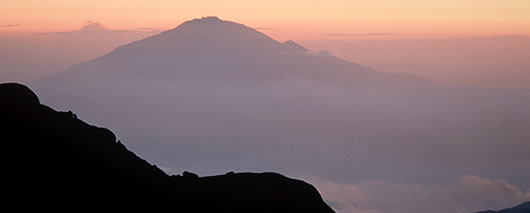The Kilimanjaro Glacier Controversy
Kilimanjaro’s glaciers have tended to be seen in scientific circles as the canary in the coal mine in the study of current climate change, with sides drawn and debates heated in the matter of whether the iconic mountain’s glaciers are diminishing as a result of global warming, because of reduced snowfall or simply as a matter of natural climatic fluctuations.
How Threatened Are The Glaciers
The view of the National Geographic Society is always good acid test on current thinking in matters such as this, and the National Geographic has been nothing if not active in recent years in drawing attention to climate change. But even this august institution cannot seem to make up its mind on this particular issue.
In a 2003 article on the subject National Geographic echoed the common view that Mount Kilimanjaro’s glacier cap would be gone by 2020, if not sooner. More recently, however, an article was published in the May 2007 online issue that predicted the glaciers might in fact be less threatened than previously thought, and that we could see Kilimanjaro’s defining white crown until at least 2050, if not longer.
What Is Causing The Decline?
What has been established, however, is that the disappearance of the glacier fields of Kilimanjaro seems to have less to do with the broader problems of climate change than rapidly evolving conditions on the ground. Tropical glaciers, including those of the neighboring Rwenzori Mountains and Mount Kenya, have been in retreat for all of this century, with observations tending to define noticeable changes from about 1800 onwards. This, it has also been noticed, corresponds with a drop in the levels of the local Rift Valley lakes, and a general decrease in precipitation.
With or without the added impetus of global warming the accelerated pace of land clearing in the region around the base of the mountain, and in East Africa generally, does indeed concur with a very rapid decrease in ice cover. Mostly this has been blamed on indiscriminate slash and burn agriculture, the loss of canopy cover, and the burning of forest for the sake of gathering honey.
What Can Be Done
It is curtailing this tendency, in fact, that many scientist says is more important than saving the glacier, if in fact that was possible. The assumption that the disappearance of the glacier would automatically dry up the mountain streams that support populations at lower altitudes is faulty, and it is in fact ordinary tropical rainfall on the intermediate slopes that water the lower elevations. It is therefore presumed that the rapid destruction of forest cover is far more potentially catastrophic than the mere loss of a handful of inconsequential glaciers.
Both factors, of course, are interlinked, and both point to hard times ahead if aggressive government and national park action to protect the heavily forested flanks of the mountain fail. Nothing can be done on a local level to affect global warming, and possibly nothing to halt population pressure either, but at least the causes are more local, and if nothing else the revenues from mass tourism, if honestly directed back into the community, would go some way to giving the ecology a value other than direct exploitation.
The Potential Threat To Tourism
Many agencies, however, also plead the fact that tourism too would suffer as a consequence of glacial loss. This might be true to a degree, but to a degree only. People would still be drawn to climb Kilimanjaro because it is what it is, and not because it has lost some part of its historic image. Kilimanjaro is the highest point on the African continent. It is a tropical feature which means that it enjoys a high degree of ecological diversity, which in turn adds much to its fascination. It is moreover one of the continental giants, a major mountain by any standard, and a significant feature on the world mountaineering circuit. As well as all these facts it is also one of a few of the world’s big mountains that is accessible to hikers and trekkers, and will therefore remain popular as a tourist destination with or without its glacier.
Check out an excellent National Geographic video on the Kilimanjaro glacier issue
